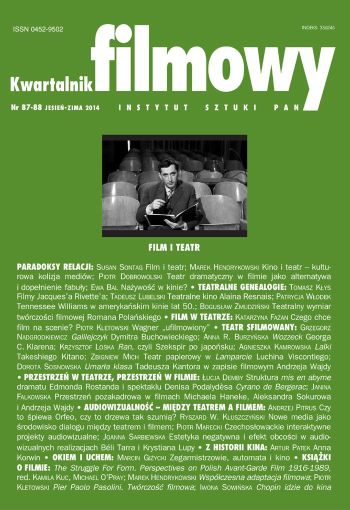Nażywość w kinie? O problematyczności odbioru "Salò, czyli 120 dni Sodomy" Piera Paola Pasoliniego
Liveness in the Cinema? On the problematical reception of "Salò, or the 120 Days of Sodom" by Pier Paolo Pasolini
Author(s): Ewa BalSubject(s): Theatre, Dance, Performing Arts
Published by: Instytut Sztuki Polskiej Akademii Nauk
Keywords: Liveness; Auslander Philip; Pasolini Pier Paolo
Summary/Abstract: The author examines the relationship between theatre and cinema in the context of contemporary tendency of films not as “works of art” depicting some fictitious “there and then”, but as testimonies to the experience of “living in art”. Bal in her analysis refers to the category of “liveness” proposed by Philip Auslander, according to whom historically variable dynamics of the effect of reality of the spectacle produced in viewers, decides on the feeling of “liveness”, and not the ontological classification between different forms of presenting of theatre, television and film. However, according to Auslander, filmmakers, unlike people working in television and the new media, failed to colonise “liveness”, as the question of repetition and the time gap between the act of creation of film and the time of its reception stood in their way. Referring to the historical and contemporary collection of testimonies of the reception of "Salò, or the 120 Days of Sodom" (1975), directed by Pier Paolo Pasolini, and the way body is shown in the film, the author questions the last thesis of Auslander and shows that even in the reception of a film, the difference between “picture” treated as a work of art and direct and immediate event touching the viewers here and now is blurred, and that because of that also film can produce the effect of “liveness”.
Journal: Kwartalnik Filmowy
- Issue Year: 2014
- Issue No: 87-88
- Page Range: 44-50
- Page Count: 7
- Language: Polish

